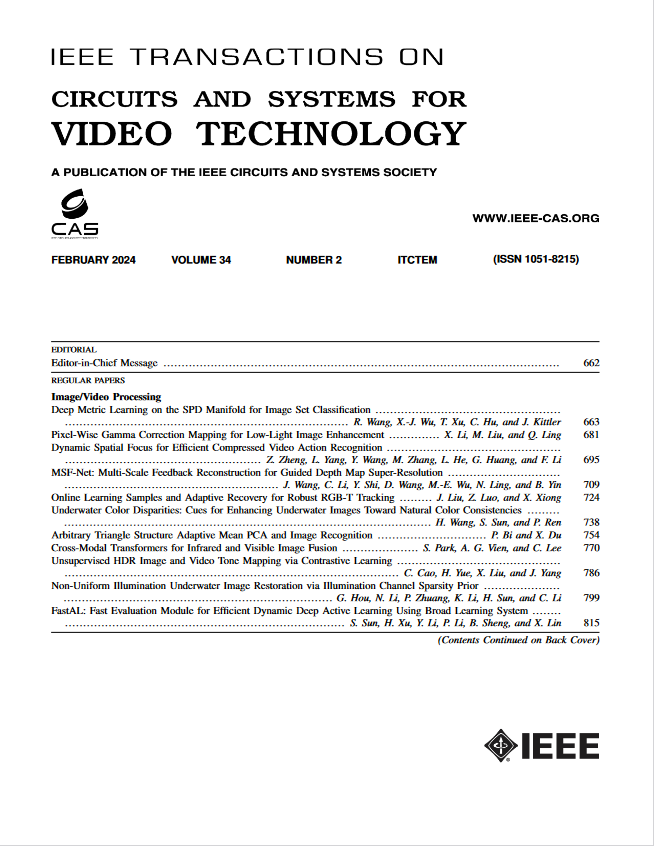Cover Selection in Encrypted Images
IF 8.3
1区 工程技术
Q1 ENGINEERING, ELECTRICAL & ELECTRONIC
IEEE Transactions on Circuits and Systems for Video Technology
Pub Date : 2024-08-22
DOI:10.1109/TCSVT.2024.3447913
引用次数: 0
Abstract
Existing effective cover selection methods aim to select the complex images as covers to achieve the highly security with the aid of the embedding distortion computed from a natural image. However, the calculation of the embedding distortion divulges the image content to a steganographer. To overcome this issue, this work proposes a novel cover selection scheme in encrypted images to achieve the image content-protection and cover-selection simultaneously. In the first phase, the content owner encrypts several most significant bits (MSBs) of each image using an encryption key and the encrypted image is shuffled by block. Meanwhile, with a sampling key, the content owner selects some encrypted blocks and outputs them to the steganographer. In the second phase, the steganographer calculates first-order noise residuals of adjacent pixels of the acquired blocks along different directions. Importantly, we design a texture descriptor named as structured Local binary pattern (SLBP) to encode all the residuals by which the images owing the maximal SLBP values are chosen as the optimal covers. We demonstrate the security of our proposed scheme on multiple steganographic and steganalytic methods and the extensive results show that our scheme exhibits excellent performance without knowing of the original image content. Moreover, the results testify that the designed SLBP achieves the perfect evaluation of image complexity.加密图像中的封面选择
现有有效的掩体选择方法都是借助自然图像计算的嵌入失真来选择复杂图像作为掩体,以达到较高的安全性。然而,嵌入失真的计算将图像内容泄露给了隐写者。为了解决这一问题,本文提出了一种新的加密图像封面选择方案,同时实现了图像内容保护和封面选择。在第一阶段,内容所有者使用加密密钥加密每个图像的几个最高有效位(msb),并按块对加密的图像进行洗牌。同时,使用采样密钥,内容所有者选择一些加密块并将其输出给隐写术者。在第二阶段,隐写术者沿不同方向计算所获取块的相邻像素的一阶噪声残差。重要的是,我们设计了一个名为结构化局部二值模式(SLBP)的纹理描述符来对所有残差进行编码,从而选择具有最大SLBP值的图像作为最优覆盖。我们在多种隐写和隐写分析方法上证明了我们的方案的安全性,广泛的结果表明,我们的方案在不知道原始图像内容的情况下具有优异的性能。实验结果表明,所设计的SLBP能够很好地评价图像的复杂度。
本文章由计算机程序翻译,如有差异,请以英文原文为准。
求助全文
约1分钟内获得全文
求助全文
来源期刊
CiteScore
13.80
自引率
27.40%
发文量
660
审稿时长
5 months
期刊介绍:
The IEEE Transactions on Circuits and Systems for Video Technology (TCSVT) is dedicated to covering all aspects of video technologies from a circuits and systems perspective. We encourage submissions of general, theoretical, and application-oriented papers related to image and video acquisition, representation, presentation, and display. Additionally, we welcome contributions in areas such as processing, filtering, and transforms; analysis and synthesis; learning and understanding; compression, transmission, communication, and networking; as well as storage, retrieval, indexing, and search. Furthermore, papers focusing on hardware and software design and implementation are highly valued. Join us in advancing the field of video technology through innovative research and insights.

 求助内容:
求助内容: 应助结果提醒方式:
应助结果提醒方式:


